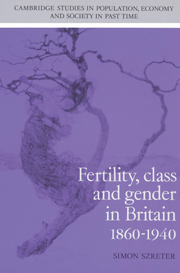Book contents
- Frontmatter
- Contents
- List of figures
- List of tables
- Acknowledgements
- List of abbreviations
- Introduction
- Part I Historiographical introduction: a genealogy of approaches
- Part II The professional model of social classes: an intellectual history
- Part III A new analysis of the 1911 census occupational fertility data
- 6 A test of the coherence of the professional model of class-differential fertility decline
- 7 Multiple fertility declines in Britain: occupational variation in completed fertility and nuptiality
- 8 How was fertility controlled? The spacing versus stopping debate and the culture of abstinence
- Part IV Conceptions and refutations
- Appendices
- Bibliography
- Index
- Cambridge Studies in Population, Economy and Society in the Past Time
8 - How was fertility controlled? The spacing versus stopping debate and the culture of abstinence
Published online by Cambridge University Press: 16 February 2010
- Frontmatter
- Contents
- List of figures
- List of tables
- Acknowledgements
- List of abbreviations
- Introduction
- Part I Historiographical introduction: a genealogy of approaches
- Part II The professional model of social classes: an intellectual history
- Part III A new analysis of the 1911 census occupational fertility data
- 6 A test of the coherence of the professional model of class-differential fertility decline
- 7 Multiple fertility declines in Britain: occupational variation in completed fertility and nuptiality
- 8 How was fertility controlled? The spacing versus stopping debate and the culture of abstinence
- Part IV Conceptions and refutations
- Appendices
- Bibliography
- Index
- Cambridge Studies in Population, Economy and Society in the Past Time
Summary
The spacing versus stopping debate
The previous chapter has explored the pattern of falling fertility evident in the detailed occupational data derived from the 1911 census; and it sought to offer some preliminary analysis to account for the social diversity that was found. Before further intellectual progress can be made with the most fundamental questions of why different sections of society began to change their fertility behaviour so dramatically during this particular period, it will be of great assistance first to investigate how the regulation of births within marriage was achieved.
In this area of intimate behaviour, direct testimony of a representative kind, on any scale, on reasons for birth control or techniques employed is virtually absent from the historical record of Victorian and Edwardian Britain. It has therefore proved equally as difficult for historians and demographers to discover which were the most important methods used to control births as it has been to reconstruct the principal motives involved. To establish with some confidence how birth regulation within marriage was achieved during the decades before the Great War would, therefore, in itself be an important advance in our knowledge. In this chapter the 1911 census data is further explored, alongside other relevant primary sources from the period, in an attempt to provide an answer to this question.
There are two related, but formally and empirically independent, kinds of questions regarding how birth control was achieved.
- Type
- Chapter
- Information
- Fertility, Class and Gender in Britain, 1860–1940 , pp. 367 - 440Publisher: Cambridge University PressPrint publication year: 1996
- 2
- Cited by

